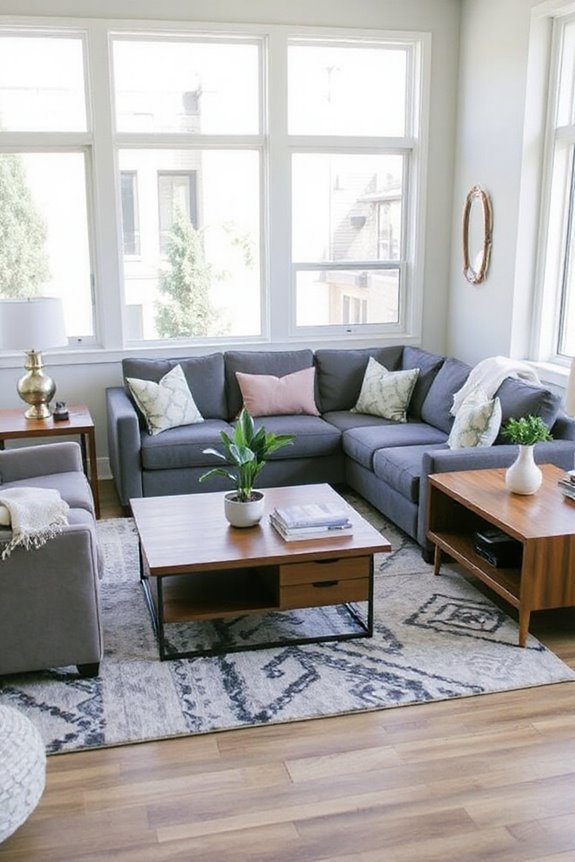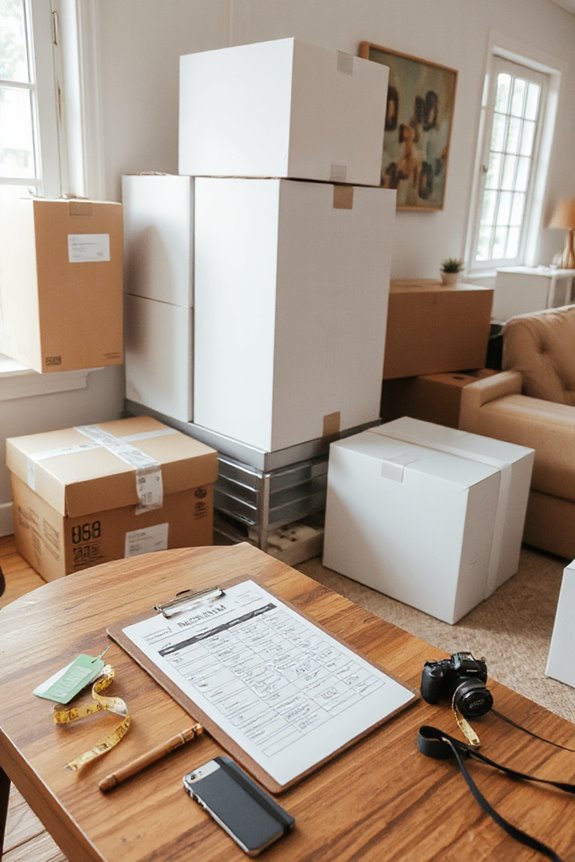To pack furniture for climate-controlled storage, start by cleaning it well—who wants unwanted odors or allergens, right? Disassemble pieces if you can; it’ll save space and make reassembly easier later! Use bubble wrap for delicate surfaces and furniture covers for added protection. Don’t forget to leave some air space between items for circulation. Curious about how to make your storage even smarter? Stick around to uncover more tips and tricks for superior results!
Key Takeaways
- Clean your furniture thoroughly to prevent odors, stains, and pests before packing for storage.
- Disassemble large pieces carefully, labeling parts and taking photos for easier reassembly.
- Wrap items in bubble wrap and use furniture covers for extra protection against dust and damage.
- Maintain space between pieces for air circulation, preventing moisture accumulation and mold growth.
- Utilize smart climate monitoring to ensure stable temperature and humidity levels in the storage unit.
Importance of Cleaning Furniture Before Storage
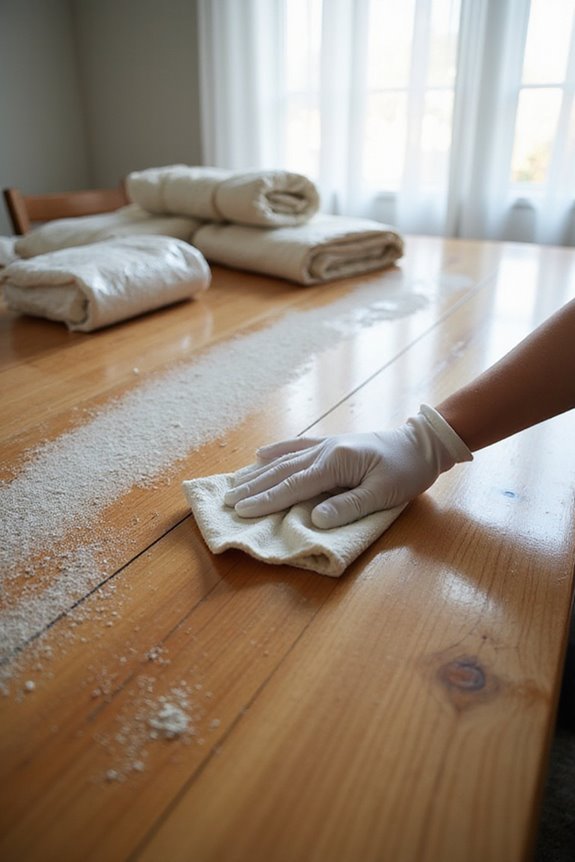
When you’re getting ready to store your furniture, you might not think about cleaning it first, but trust me—it’s super important! Using the right cleaning techniques can prevent odors, mold, and allergens from taking over your precious pieces. Imagine opening your storage unit and being greeted by a musty smell—not fun, right?
Have you ever noticed how stains seem to multiply over time? Cleaning can help you dodge that disaster! Plus, it protects your fabric and wood finishes, enhancing their durability. So, why not invest a little time upfront? The storage benefits are huge! By ensuring everything’s clean before storage, you’re setting up your furniture for a long, happy life. Who wouldn’t want that? Additionally, proper cleaning can preserve the quality craftsmanship of your furniture, ensuring it remains in excellent condition during storage.
Steps for Disassembling Furniture Safely

Cleaning your furniture before storing it is a great start, but what about disassembling it? First, gather essential tools like screwdrivers and wrenches. Make certain to wear safety gloves and protective eyewear. Safety measures are key! Clear your workspace and guarantee it’s well-lit. Got a camera? Snap photos of your furniture before you start—this’ll help during reassembly!
Next, remove any cushions or upholstery carefully. Label screws and small parts in bags so you don’t lose anything. Use disassembly techniques like taking it apart in sections to make it easier. Oh, and if you’re unsure about handling glued parts, don’t hesitate to call in a pro! Following these steps will keep your furniture safe and sound while stored! Additionally, consider using high-density foam for cushioning when packing disassembled parts to prevent damage during storage.
Assessing Furniture Condition for Repairs
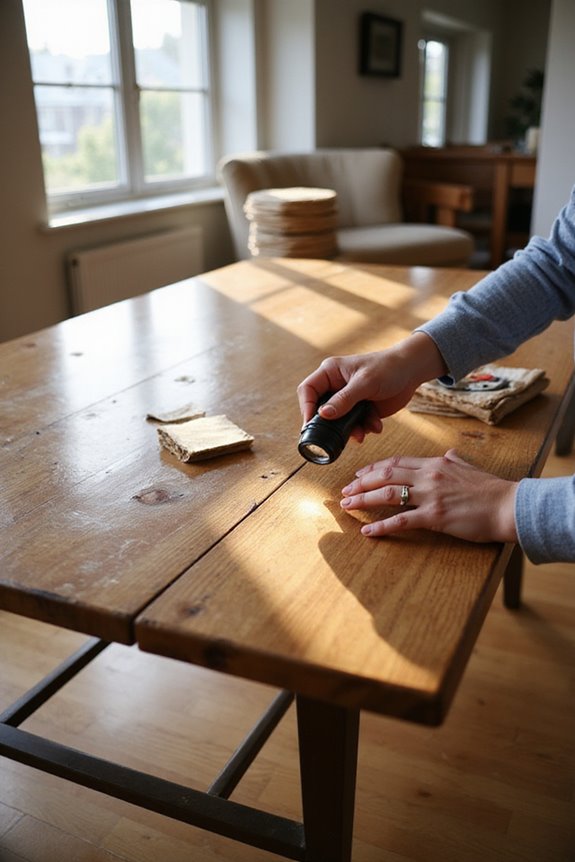
Before you toss that furniture in storage, let’s take a moment to assess its condition—trust me, you’ll thank yourself later! Start with a thorough furniture inspection: check for scratches, dents, or any stains that might worsen. Got upholstery? Look for rips or wear that could invite pests; yikes!
Then, test stability—does it wobble? Give those joints a little push to check for gaps. Don’t forget about moisture! A quick smell test can reveal mold or mildew.
Finally, let’s get some damage documentation going. Make notes on your findings, even snap a few photos. This way, you’ll have all the info for future repairs. Additionally, consider using durable upholstery options to enhance the longevity of your furniture. Aren’t you glad you took the time? Your furniture will thank you!
Proper Protection Techniques for Furniture
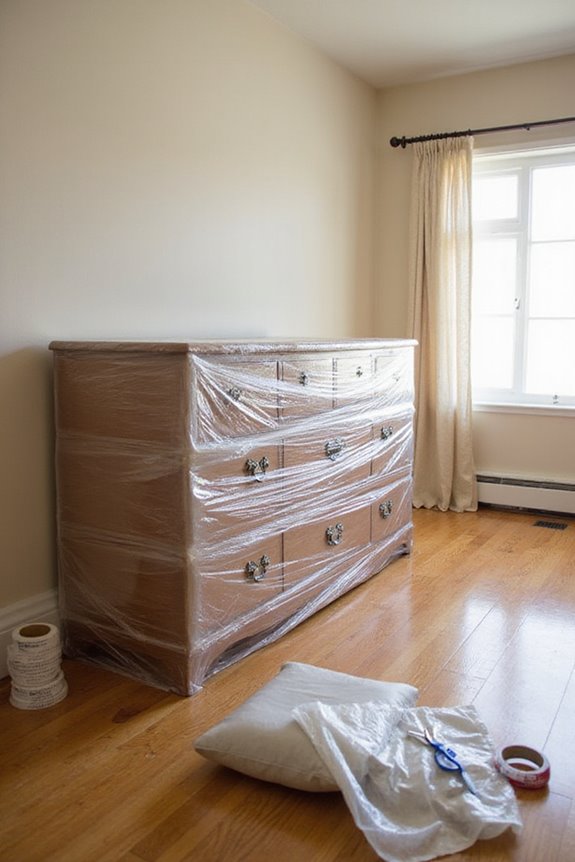
Protecting your furniture during storage isn’t just a good idea—it’s essential if you want to keep your pieces looking sharp and ready for action! So, what packing techniques should you use? Start by cleaning your furniture thoroughly to prevent stains and pests. Then, wrap items in bubble wrap and use furniture covers for that extra layer of protection. Don’t forget to leave some space between pieces for air circulation. If you’re storing wooden furniture, applying furniture wax adds a nice protective layer! And hey, ever thought about furniture insurance? It’s a smart backup just in case. Keep an eye on conditions, too—stable humidity and temperature levels are key to preserving your valuable items!
Preparing the Storage Environment
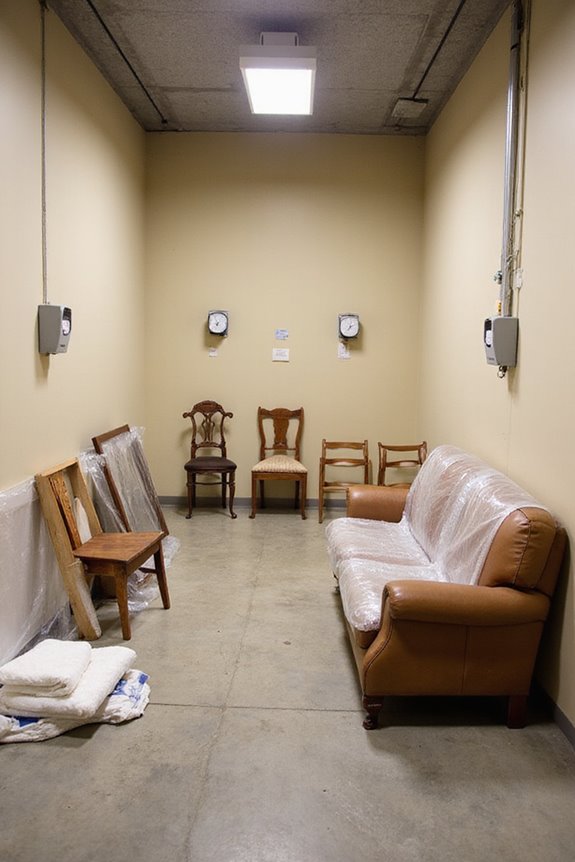
Creating the perfect environment for your furniture storage can feel like setting up your very own protective fortress! First, look for a climate-controlled unit that maintains an ideal storage temperature between 55°F and 85°F. Why? This range keeps your pieces safe from extreme heat and cold. Plus, humidity control is essential; you don’t want to find mold or warped wood when you retrieve your items!
Make certain the facility uses a reliable HVAC system to keep conditions stable. This guarantees the best protection for your furniture. It’s also smart to take into account where the facility is located—certain climates may demand extra precautions. With these steps, you’ll feel confident that your cherished pieces are safe and sound! Excited to get started?
Choosing the Right Packing Materials
When you’re getting ready to pack your furniture for storage, it’s important to choose the right packing materials that keep everything safe and sound! You’ll want to grab quality packing supplies like bubble wrap for fragile items and sturdy cardboard boxes for secure storage. Ever tried using newspapers? Yikes! Ink can transfer, so stick with acid-free packing paper instead.
For larger furniture, invest in protective padding like furniture blankets or breathable cotton sheets. They’ll save your pieces from scratches and dust. Don’t forget to add packing peanuts to fill any gaps and lower movement inside boxes! By choosing the right materials, you can rest easy knowing your furniture’s in great hands—maybe even better than yours!
Optimizing Storage Layout for Accessibility
Have you ever opened a storage unit only to feel like you’re in a maze? To keep things accessible, group similar furniture together. For example, stack chairs and tables, while placing frequently used items toward the front. Ever thought about using vertical storage? Stacking lighter items on sturdy bases maximizes space and accessibility!
Consider using modular systems to rearrange your setup as needed. And don’t forget to label everything! Clearly mark containers and create a color-coded inventory list for quick reference. This makes finding your favorite chair a breeze! Just remember to keep pathways clear so you’re not climbing over everything like it’s an obstacle course. Who wants that? A little planning now saves big time later!
Special Care for Different Furniture Materials
Taking care of different furniture materials while packing them for storage is super important if you want to keep them in tip-top shape! When it comes to wood furniture, use moisture-resistant finishes to keep warping at bay. Got a little extra space? Great! That’ll help prevent scratches and damage.
Now, for upholstered furniture, don’t forget breathable covers like cotton pads to stop moisture buildup. And how about applying some fabric protectant? It’ll help keep those pesky stains away.
Label your covered pieces too! It makes finding that favorite chair a breeze later on. So, are you feeling ready to tackle the packing? With these tips, your furniture will be stored like a pro!
Long-Term Maintenance Tips for Stored Furniture
To keep your stored furniture looking fresh and fabulous, it’s all about staying proactive! Think about creating a maintenance schedule. Every 3-6 months, you should rotate and refold your textiles. This helps prevent those annoying permanent creases! Don’t forget to flip your mattresses, too.
Also, consider having a little “exercise” routine for your mechanical furniture, like moving those recliners and lubricating hinges. It’ll keep everything in tip-top shape.
And who doesn’t love a well-organized space? When you regularly check on your furniture, you can quickly spot any issues, like pesky pests or mold. That way, you’re preventing bigger problems. Isn’t it nice knowing your furniture’s covered? Keep up the good work, and your pieces will stay fabulous!
Regular Inspection and Climate Monitoring
While storing your beloved furniture, you might wonder: how often should I check on it? A good rule of thumb is to perform regular inspections every 3-6 months. But what should you look for? Create a checklist to monitor signs of mold, mildew, or pesky pests. Keeping detailed records lets you track changes and catch issues before they grow!
Now, let’s talk climate stability. Use advanced HVAC systems to keep temperatures between 58°F and 78°F. Also, installing humidity sensors keeps everything from warping to ripping. There are even alert systems to notify you if conditions go haywire. So, do you see how regular checks and smart climate monitoring can save your favorite pieces from disaster? Let’s keep them safe and sound!
Frequently Asked Questions
What Items Should I Avoid Storing in Climate-Controlled Units?
When it comes to climate-controlled units, steer clear of hazardous materials that might ignite chaos, and remember, even non-perishable items can spoil your peace. Stick to dry, safe items, and keep the space harmonious.
How Often Should I Check on My Stored Furniture?
You should check on your stored furniture monthly to ascertain its condition. Use inspection tips like monitoring moisture and temperature levels, and maintaining an organized inventory. Regular storage frequency helps prevent potential issues and preserves your items.
Can I Use Cardboard Boxes for Long-Term Storage?
You might wonder about the longevity of cardboard boxes in storage. Unfortunately, for long-term durability, they fall short. Instead, consider sturdy cardboard alternatives, like plastic bins, to protect your belongings from moisture and pests.
What Are the Signs of Moisture Damage in Stored Furniture?
You should look for moisture indicators like water stains, warping, or musty odors. To guarantee damage prevention, store items in a climate-controlled environment and regularly check for signs of mold or deterioration.
Is It Necessary to Cover Furniture With Protective Materials?
You wouldn’t want your furniture to catch a cold, would you? Covering it isn’t just smart; it’s essential. Proper furniture protection through thoughtful storage techniques keeps dust, moisture, and pests at bay, ensuring peace of mind.


